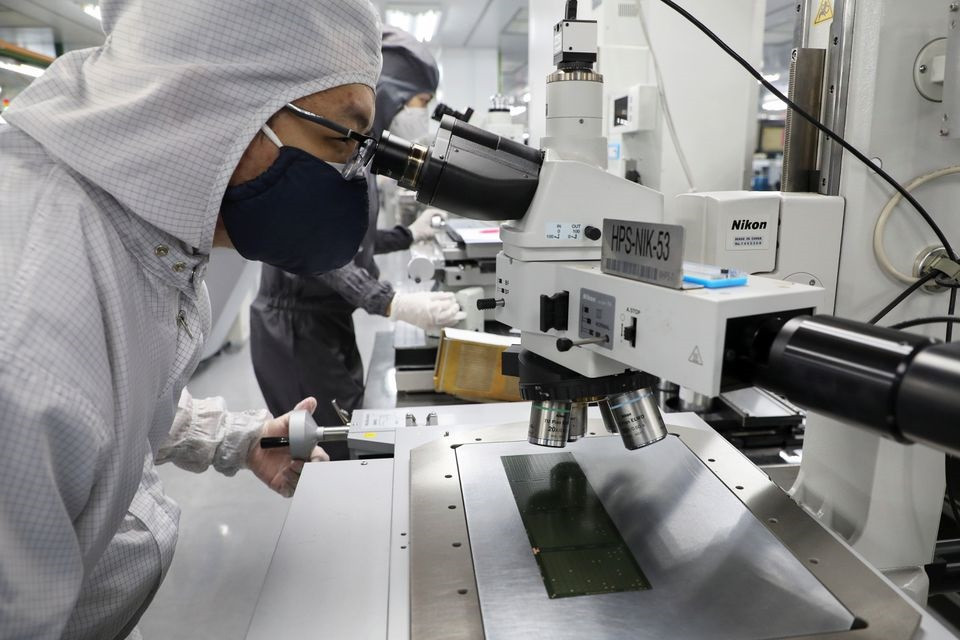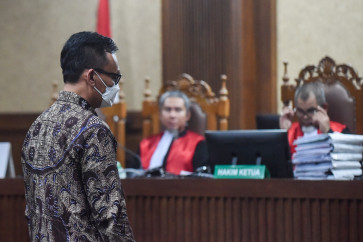Popular Reads
Top Results
Can't find what you're looking for?
View all search resultsPopular Reads
Top Results
Can't find what you're looking for?
View all search resultsIt’s time for semiconductor industry to flourish in Indonesia
Indonesia needs strong commitment to develop its homegrown semiconductor production, and put it into the list of national priority projects.
Change text size
Gift Premium Articles
to Anyone
D
uring the COVID-19 pandemic, many countries have been experiencing disruption of the global supply chain of various raw materials and products. Among the widely discussed issues is a shortage of semiconductors or chips, which are considered the "brain" of every electronic device. Many experts have predicted the shortfall may drag on until 2022/23.
According to market intelligence firm IDC, more than 300 million personal computers (PCs) were sold in 2020, up from 268 million in 2019. Analysts project that the demand will reach 400 million PCs by the end of 2021. The shortage of semiconductors affects computer manufacturers, rendering some of them unable to fulfil orders. The disrupted supply is also adversely affecting production of other high tech electronic devices.
The World Semiconductors Trade Statistics (WSTS) recorded the trade value of semiconductors in 2019 stood at US$420.7 billion. Despite the pandemic, it rose to $452.25 billion in 2020. By the end of the year it is estimated to reach $527.2 billion. With an annual growth of 8.6 percent, the global market in 2028 will reach $803.15 billion.
Indonesia’s road to Industry 4.0, which relies on the internet and artificial intelligence is certainly an electronic base. In the absence of local semiconductors, national electronics industries only have one choice: bringing in parts to be assembled domestically. Expansion of the Local Content Level (TKDN) on electronic products will never reach a wholly Indonesian-made product if the main components are still imported.
So far, there is no integrated data of semiconductor imports. However, if Indonesia’s modern life is inseparable from electronic devices and semiconductors are the core, subsequently imports will drain foreign exchange reserves. The so-called Program Laptop Merah Putih (red and white laptop program), which is projected to provide 431,730 locally made laptops to students across the country this year will also be affected by the shortage.
Manufacturing semiconductors needs high tech nanotechnology. Professor of nanotechnology, Jeremy Ramsden, in his book Applied Nanotechnology: The Conversion of Research Results to Products in 2014, stated that nanotechnology is: the design, characterization, production, application of materials, devices and systems by controlling their shape and size at the nanoscale (smaller than atom).
The unit measure used in this technology is the nanometer (Nm), in which 1 Nm equals to 1/1 billionth of a meter. For comparison, the average size of each strand of human hair is 60,000-100,000 Nm. With nanotechnology, the use of materials for every product will be much smaller, but with similar, or even better, performance.
The development of nanotechnology must be supported by various other related basic sciences such as: organic chemistry, molecular biology, semiconductors physics, energy storage, engineering, micro fabrication, molecular engineering and others. It also requires extensive research and huge investment. Therefore, nanotechnology, which is the basis for semiconductor production, is still dominated by developed countries.
Currently, semiconductor companies may choose to participate in one among three production processes according to their location, business model, capital and human resources: design, front-end fabrication and back-end assembly, which comprises testing and packaging.
Subsequently, countries are competing to have the industry not only fulfil the domestic market but also to elevate their exports. Some ASEAN countries have been involved in the sector, either as a branch of large companies from developed countries or as a new company that chooses a stage in the production process. In Singapore, there are 10 semiconductor companies, while in Malaysia nine, in Thailand six and in Vietnam four companies.
With the fourth largest population in the world, Indonesia is a large market, especially for electronic devices that have increasingly become a basic necessity. When will Indonesia start reducing imports and fulfilling the need for core electronic components with domestic products?
The Industry Ministry has noted that Indonesia once had a semiconductor industry which was managed by two United States companies, namely Fairchild Semiconductors International and National Semiconductors in 1973. Unfortunately, the operation of the two companies did not last long. In the 1980s they left Indonesia for good.
For the time being, there are limited options but to rely on imports. Yet, Indonesia must quickly attract investors to get involved in semiconductor production. The fastest, cheapest and without requiring relatively many highly skilled workers is to jump to the third stage: back-end assembly, testing and packaging as many other ASEAN countries do.
To achieve self-reliance, it needs several preparations. First, strong commitment to developing home-grown semiconductor production, and putting it on the list of national priority projects.
Second, to refocus higher education programs on sciences that support nanotechnology. Universities as the forerunners in research and scientist incubators should always be encouraged. Furthermore, preparing more skilled workers can be achieved through polytechnics that directly collaborate with the industry.
Third, to create a more competitive investment ecosystem. It is necessary to ensure various aspects, not only the technical but also regulations, political and security stability as well as economic costs that enable investors to calculate the industry better.
Fourth, to set a clear plan for the electronics industry from upstream to downstream that leads to fully local manufacturing. Otherwise, industries will tend to invest only in certain products that are relatively simple, or even switch to being traders to fulfill short-term market gaps.
Fifth, to provide necessary facilities. In the initial stage, the high tech industry is mostly driven by the state because of its high risks. To encourage private involvement, several facilities should be offered, such as taxes, suitable locations, import and export processes.
Lastly, to support research and development. The high technology industry has strategic aspects including defense and security. The state's support is not only for the sake of economic consideration but also in its direction and policies.
To conclude, it is never too late to become self-reliant in the electronics sector. It needs consistency so it will not always be trapped in the vortex of “it's easier and cheaper to import than to produce”, which will only perpetuate imports and is the antithesis of self-reliance.
***
The writers is deputy chief mission of the Indonesian Embassy in Singapore. These views are his own.










